Samurai Swords - Technically a Misnomer
 The Samurai Sword is unique in it s appearance. There is perhaps, no more recognizable weapon than that of the Samurai Sword. It s long slender blade with a history of discipline and honor in the form of the «Bushido bdquo or their ethical code, coupled with the fine craftsmanship, is reason enough to make this a highly sought after weapon and work of art. The term ldquo Samurai Sword» is a misnomer however. The Samurai Sword has become synonymous with the Samurai s sword the «Katana» with it s shorter companion the «Wakizashi bdquo. Together they form what is referred to as the ldquo Daisho». The Samurai were the warrior class that sprang from the early 7th ndash 9th centuries as a result of the Emperor s need to quash the rebellions within his kingdom.
The Samurai Sword is unique in it s appearance. There is perhaps, no more recognizable weapon than that of the Samurai Sword. It s long slender blade with a history of discipline and honor in the form of the «Bushido bdquo or their ethical code, coupled with the fine craftsmanship, is reason enough to make this a highly sought after weapon and work of art. The term ldquo Samurai Sword» is a misnomer however. The Samurai Sword has become synonymous with the Samurai s sword the «Katana» with it s shorter companion the «Wakizashi bdquo. Together they form what is referred to as the ldquo Daisho». The Samurai were the warrior class that sprang from the early 7th ndash 9th centuries as a result of the Emperor s need to quash the rebellions within his kingdom.
Категория поста: English
Alloying Elements in Titanium
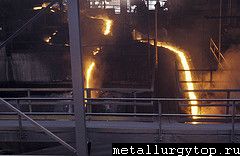 In the solid state, the titanium alloys are arranged in either hexagonal close ndash packed (alpha) or body ndash centered cubic (beta) structure. Pure titanium undergoes an allotropic transformation from hexagonal close ndash packed (HCP) alpha titanium to body ndash centered cubic (BCC) beta titanium as its temperature is raised through 882 C (1620 F). The melting point of pure titanium is 1668 C (3034 F). Aluminum is the most widely used alloying element in titanium ndash based alloys. It is the only common metal that raises the beta transus temperature and have large solubilities in both the alpha and beta phases. Elements such as aluminum, oxygen, nitrogen, carbon, gallium, germanium, lanthanum, and cerium stabilize the alpha phase to higher temperature and are thus referred to as alpha stabilizers. In general, transition metals and noble metals (i.e.,
In the solid state, the titanium alloys are arranged in either hexagonal close ndash packed (alpha) or body ndash centered cubic (beta) structure. Pure titanium undergoes an allotropic transformation from hexagonal close ndash packed (HCP) alpha titanium to body ndash centered cubic (BCC) beta titanium as its temperature is raised through 882 C (1620 F). The melting point of pure titanium is 1668 C (3034 F). Aluminum is the most widely used alloying element in titanium ndash based alloys. It is the only common metal that raises the beta transus temperature and have large solubilities in both the alpha and beta phases. Elements such as aluminum, oxygen, nitrogen, carbon, gallium, germanium, lanthanum, and cerium stabilize the alpha phase to higher temperature and are thus referred to as alpha stabilizers. In general, transition metals and noble metals (i.e.,
Категория поста: English
Selecting a High Quality Sword
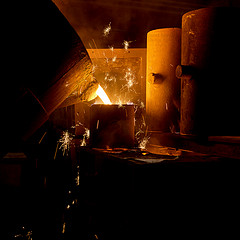 You should already know what goes into a sword blade and that you should avoid stainless steel and floppy spring steel. If not, please speak with your instructor about it, or visit with us and we can give you a thorough introduction to metallurgy. The rest of your decision making process will deal primarily with the quality of the fittings, and their proper assembly. Here is a simple checklist you can use when selecting a sword. What kind of steel is it? For cheap swords that will never see contact or hard movements, stainless steel or floppy Asian spring steel is somewhat acceptable. What kind of temper has it had? A high quality sword should be differentially tempered. Is it too floppy, or too rigid? Too floppy and it is useless and even dangerous.
You should already know what goes into a sword blade and that you should avoid stainless steel and floppy spring steel. If not, please speak with your instructor about it, or visit with us and we can give you a thorough introduction to metallurgy. The rest of your decision making process will deal primarily with the quality of the fittings, and their proper assembly. Here is a simple checklist you can use when selecting a sword. What kind of steel is it? For cheap swords that will never see contact or hard movements, stainless steel or floppy Asian spring steel is somewhat acceptable. What kind of temper has it had? A high quality sword should be differentially tempered. Is it too floppy, or too rigid? Too floppy and it is useless and even dangerous.
Категория поста: English
Basic Metallurgy of Swords
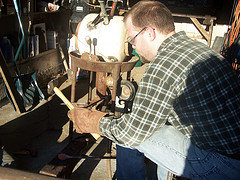 In your martial arts journey you are likely to own a variety of swords, and will almost absolutely face a multitude of choices. How do you choose? How do you pick the right one? Well, the first question is the reason for this article. The second question, however, has an easy answer ndash ndash there is no such thing as «the right one bdquo. You should be thinking instead of ldquo the right tool for the job». Different sword strengths and geometries will be more appropriate for different actions. You need to let the functionality dictate which sword to use for that particular job. So, on to answer the first question, this will also help guide you in the second. Before you buy, you should take some time to study these issues.
In your martial arts journey you are likely to own a variety of swords, and will almost absolutely face a multitude of choices. How do you choose? How do you pick the right one? Well, the first question is the reason for this article. The second question, however, has an easy answer ndash ndash there is no such thing as «the right one bdquo. You should be thinking instead of ldquo the right tool for the job». Different sword strengths and geometries will be more appropriate for different actions. You need to let the functionality dictate which sword to use for that particular job. So, on to answer the first question, this will also help guide you in the second. Before you buy, you should take some time to study these issues.
Категория поста: English
Annealing and Metallurgy - The Different Stages and Processe
 The process is commonly seen to involve steps like heating above temperature then normalizing it. After which, cooling of the material will be necessary. It softens a material or induces ductility while shaping, forming or stamping it to the desired output. Three stages are linked to the annealing process, namely: Recovery phase. This is that point when the metal is softened by means of removing defects on the crystals and whatever internal stress the dislocation causes. This stage covers the instance before any stains or grains are seen on the material. Recrystallization phase. This is the phase when new grains grow on the material. This is said to replace those that were deformed and removed during the recovery phase. Grain growth phase. This stage results to a problem on the material.
The process is commonly seen to involve steps like heating above temperature then normalizing it. After which, cooling of the material will be necessary. It softens a material or induces ductility while shaping, forming or stamping it to the desired output. Three stages are linked to the annealing process, namely: Recovery phase. This is that point when the metal is softened by means of removing defects on the crystals and whatever internal stress the dislocation causes. This stage covers the instance before any stains or grains are seen on the material. Recrystallization phase. This is the phase when new grains grow on the material. This is said to replace those that were deformed and removed during the recovery phase. Grain growth phase. This stage results to a problem on the material.
Категория поста: English
Understanding Ferrous Metallurgy and Sheet Metal
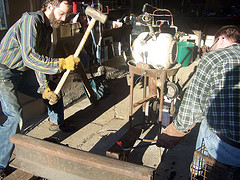 Ferrous metallurgy at first seems like a fancy, and perhaps antiquated, art form. But it is just a technical way of saying ironwork. Ferrous is a word derived from the Latin word ferrum, and simply refers to substances containing or consisting of iron. Ferrous metals include steel and pig iron (with a carbon content of a few percent) and alloys of iron with other metals (such as stainless steel). The term non ndash ferrous is used to indicate metals other than iron and alloys that do not contain an appreciable amount of iron. Metallurgy is the branch of science and technology concerned with the properties of metals and their production and purification. The History of Ferrous Metallurgy: Working with iron has a rich and detailed global story. Metalworking began well before humans began recording history.
Ferrous metallurgy at first seems like a fancy, and perhaps antiquated, art form. But it is just a technical way of saying ironwork. Ferrous is a word derived from the Latin word ferrum, and simply refers to substances containing or consisting of iron. Ferrous metals include steel and pig iron (with a carbon content of a few percent) and alloys of iron with other metals (such as stainless steel). The term non ndash ferrous is used to indicate metals other than iron and alloys that do not contain an appreciable amount of iron. Metallurgy is the branch of science and technology concerned with the properties of metals and their production and purification. The History of Ferrous Metallurgy: Working with iron has a rich and detailed global story. Metalworking began well before humans began recording history.
Категория поста: English
The Four Different Types of Metals and Their Contribution to
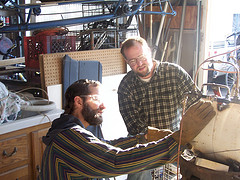 The earth is indeed an amazing and perfect place to live. It has the things that are necessary for us to survive. It provides with the enough resources for our needs. There is no place like earth. Humans are the highest level of organism living on this planet. We are even termed as the stewards of this place. Although plants and animals are also considered as living organisms, humans are given the chance and the will to utilize the natural resources that can be found on earth. These natural resources include plants, wood and minerals. Metal is one of the oldest minerals on this planet. It has been used in different reasons. During the early civilizations metal has been used as a weapon. It is very much known for its hardness and durability.
The earth is indeed an amazing and perfect place to live. It has the things that are necessary for us to survive. It provides with the enough resources for our needs. There is no place like earth. Humans are the highest level of organism living on this planet. We are even termed as the stewards of this place. Although plants and animals are also considered as living organisms, humans are given the chance and the will to utilize the natural resources that can be found on earth. These natural resources include plants, wood and minerals. Metal is one of the oldest minerals on this planet. It has been used in different reasons. During the early civilizations metal has been used as a weapon. It is very much known for its hardness and durability.
Категория поста: English
Production of Metallic Elements Through Metallurgy
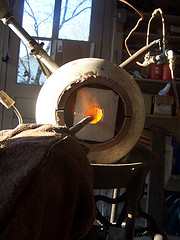 Metallurgy is the manufacture of metallic components used in engineering or consumer products. It involves the fabrication of alloys, the formation, the treatment of heat and surface treatment of the item for consumption. Metallurgy is very common in production engineering. The primary task of a metallurgist is to attain stability between properties of materials like cost, strength, weight, hardness, corrosion, toughness, fatigue resistance and performance in extreme heat. To attain this aim, the working environment should be considered carefully. Ferrous metals and a few aluminum alloys rust rapidly in saltwater location. Metals uncovered to cryogenic or cold conditions might suffer ductile to breakable transition and may lose their hardiness and become more breakable and inclined to cracking. Metals under continuous stress at high temperatures may creep. They can also endure metal fatigue if they under constant cyclic loading.
Metallurgy is the manufacture of metallic components used in engineering or consumer products. It involves the fabrication of alloys, the formation, the treatment of heat and surface treatment of the item for consumption. Metallurgy is very common in production engineering. The primary task of a metallurgist is to attain stability between properties of materials like cost, strength, weight, hardness, corrosion, toughness, fatigue resistance and performance in extreme heat. To attain this aim, the working environment should be considered carefully. Ferrous metals and a few aluminum alloys rust rapidly in saltwater location. Metals uncovered to cryogenic or cold conditions might suffer ductile to breakable transition and may lose their hardiness and become more breakable and inclined to cracking. Metals under continuous stress at high temperatures may creep. They can also endure metal fatigue if they under constant cyclic loading.
Категория поста: English
Welding Inspector Profession
 Welding inspector is a part of QA QC that involve in the welding work. He is responsible for doing inspection before, during and after welding. Starting from inspection of material receiving till the part completely welded. To become a certified inspector, you need to pass some requirement. You need to have some years hands ndash on experience while working then taking a certification, or if you have higher level education that related to metallurgy then after 1 3 years experience in welding you can take the course international certification such as CSWIP 3.1 (Certification Scheme for Welding Inspection Personnel 3.1) or CWI (Certified Welding inspector. Your certification achievement status to one of the international certification bodies above signals a degree of professionalism and commitment that you are take seriously in welding inspector profession and typically will reward you with higher wages.
Welding inspector is a part of QA QC that involve in the welding work. He is responsible for doing inspection before, during and after welding. Starting from inspection of material receiving till the part completely welded. To become a certified inspector, you need to pass some requirement. You need to have some years hands ndash on experience while working then taking a certification, or if you have higher level education that related to metallurgy then after 1 3 years experience in welding you can take the course international certification such as CSWIP 3.1 (Certification Scheme for Welding Inspection Personnel 3.1) or CWI (Certified Welding inspector. Your certification achievement status to one of the international certification bodies above signals a degree of professionalism and commitment that you are take seriously in welding inspector profession and typically will reward you with higher wages.
Категория поста: English